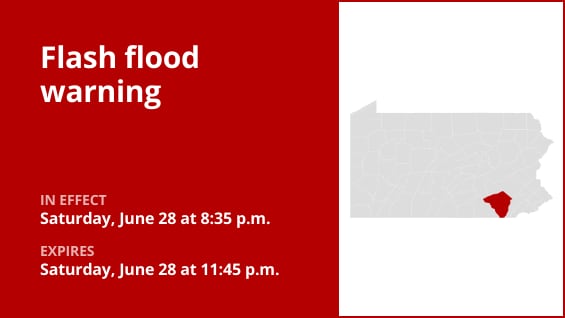At 8:35 p.m. on Saturday, the National Weather Service issued a flash flood warning for Lancaster County, which was in force until 11:45 p.m.
“Doppler radar showed thunderstorms causing heavy rain in the notified area at 8:35 p.m. It has rained up to 1.5 inches. The cautioned area may see an additional 1 to 1.5 inches of rainfall. According to the weather service, flash flooding is either already occurring or is predicted to start soon. “Flash flooding of small creeks and streams, urban areas, highways, streets and underpasses as well as other poor drainage and low-lying areas.”
The following locations are affected by the warning: Safe Harbor, Lampeter, Intercourse, Conestoga, Washington Boro, Gordonville, Bird-In-Hand, Smoketown, Refton, Millersville, Willow Street, East Petersburg, Paradise, Salunga-Landisville, Strasburg, Mountville, Smithville, and Millersville University.
“Turn around, don’t drown when encountering flooded roads,” the weather agency advises. Vehicles are the primary cause of flood fatalities. Avoid driving on flooded roads and pay attention to your surroundings.
Understanding the differences between advisories, watches, and warnings
-
Flash flood warning: Take action!
When a flash flood is approaching or already happening, a warning is sent. Get to high ground right away if you’re in a flood-prone location. A flash flood is a quick, intense flood that can form in a matter of minutes to hours. Even in places that don’t get rain right away, flash floods can happen.
-
Flood warning: Take action!
When flooding is expected or is happening, a flood warning is issued.
-
Flood advisory: Be aware:
When flooding is not predicted to become severe enough to warrant a warning, a flood advisory is issued. However, it still has the potential to be extremely inconvenient and, if careless, to result in circumstances that endanger life and/or property.
-
Flood watch: Be prepared:
When the weather is conducive to flooding, a flood watch is issued. Flooding is not guaranteed, but it is a possibility.
When floods strike: Guidelines from the weather service for your protection
Floods can be a serious hazard, particularly if you live in a flood-prone location or camp in a low-lying area. The weather service provides crucial flood protection instructions to protect you:
Look for higher ground.
Moving to higher ground should be your first course of action if you’re camping in a low-lying location or in an area that is prone to flooding.
Observe evacuation directives:
Respond quickly to any evacuation orders issued by local authorities. Secure your home by locking it before you leave.
Cut off appliances and utilities:
Disconnect your appliances and utilities if you have the time. By taking this precaution, electrical dangers during flooding are reduced.
Avoid drowned places and flooding basements:
Avoid basements or rooms with electrical outlets or cords submerged in water. This lessens the chance of electrical mishaps.
Quick evacuation to keep you safe:
Evacuate right away if you see sparks or hear popping, crackling, buzzing, or snapping sounds. Steer clear of any water that might be electrically charged.
Avoid going on foot in floodwaters:
Never try to cross flooding on foot. Six inches of quickly flowing water can knock you off your feet with force.
When stuck, look for higher ground:
If you find yourself caught by flowing water, move to the highest spot you can and dial 911 to reach rescue personnel.
Flooding is more likely to occur during times of heavy rainfall, especially in low-lying and flood-prone locations. Driving through any water on the road, even if it appears to be shallow, must be avoided. The weather service claims that 12 inches of flowing water is enough to sweep away the majority of autos. Put your safety first by being aware and ready.
Navigating rainy roads: Safety tips for wet weather
Safety comes first when there is a lot of rain. To avoid dangers and navigate wet roads, arm yourself with these weather service guidelines:
Watch out for flooding rivers:
Avoid parking or strolling close to drainage ditches or culverts during periods of intense rain, since the swift-moving water can be quite dangerous.
Keep your distances from other vehicles safe:
In heavy rain, the two-second rule of following distance is your friend. To guarantee safe spacing under unfavorable circumstances, increase it to four seconds.
Reduce your speed and exercise caution:
It’s crucial to slow down on wet roads. To avoid sliding, reduce the accelerator gradually and don’t brake suddenly.
Pick your lane carefully:
To reduce the chance of hydroplaning, stay in the middle lanes. Water is more likely to accumulate in outside lanes.
Visibility is important.
As rain-spattered windows make it more difficult to see other vehicles, turn on your headlights and pay attention to those in blind spots and behind you.
Be cautious on slick roads:
Roads are slickest during the first half-hour of rain because of a combination of rain, oil, and filth. Be especially careful during this time.
Stay a safe distance away from big cars:
Tire spray from big vehicles and buses can make it harder to see. Pass them quickly and safely, and refrain from tailgating.
Be mindful of your wipers:
-
Overloaded wiper blades can hinder visibility. If rain severely impairs your vision, pull over and wait for conditions to improve. Seek refuge at rest areas or sheltered spots.
-
When stopping by the roadside is your only option, position your vehicle as far off the road as possible, ideally beyond guardrails. Keep your headlights on and activate emergency flashers to alert other drivers of your position.
Taking these safety measures will significantly improve your road safety while it’s raining a lot. For a safe trip, keep yourself updated on weather conditions and follow local authorities’ instructions.
United Robots offers a service called Advance Local Weather Alerts that gathers the most recent information from the National Weather Service using machine learning.






